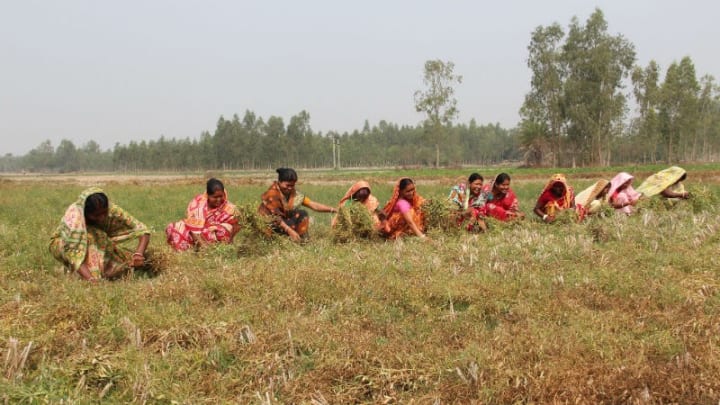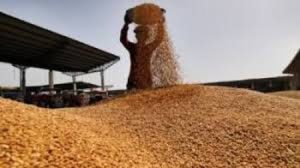
NEW DELHI — Laxmiben used to work with her husband on their farm, in a village in the western state of Gujarat, India. When he passed away, she was driven from her land by her in-laws and left to fend for herself and her daughters. It was only when paralegals from Working Group for Women and Land Ownership, an NGO that works on women’s land rights, came to her aid that she was able to claim the land that was legally hers. She now runs an organic produce business to provide for her family.
“As agriculture gets oriented towards markets, with an increasing reliance on herbicides and machines, men take over the decision-making.”— Kavitha Kuruganti, convener, Alliance for Sustainable and Holistic Agriculture
Laxmiben’s struggle is shared by many women working in agriculture across India, a country where females form the backbone of the sector. More than 70% of rural women workers are engaged in agricultural work, according to 2017-18 data published by the government’s National Sample Survey Office. In contrast to their high participation, women own 13.9% of landholdings, the agricultural census of 2015-16 found.
Women work as cultivators or agricultural laborers on small parcels of land, most of them as unpaid family labor. This type of informal, home-based work impacts official statistics and leads to underreporting of women’s work in agriculture.
“Women farmers are invariably invisibilized in data systems since land operations are the criteria by which the census enumeration systems identify farmers, and women’s toil on the land tends to be underreported in our patriarchal structures of family, state, and capitalist economy,” said Soma Parthasarathy, policy analyst and member of MAKAAM, a forum for the rights of women farmers. MAKAAM has been pressing for the recognition of women as farmers in data systems and gender-disaggregated data of farmers.
Women are estimated to carry out60-75% of all farming related work across most regions of the country — but “they are not counted as farmers and recognized,” Parthasarathy said. Instead, they are often denied sole access to land, livestock, assets, technologies, credit, irrigation, and markets, according to Parthasarathy. Men’s wages in agriculture, meanwhile, are1.4 times higher than the wages earned by women.
The agricultural sector in India is in an ongoing state of crisis. Crop failure, high cost of production, and collapses of agricultural prices have led farmers into deep debt traps. As a result, many men have committed suicide or left their farms and migrated to urban areas, transferring the burden to the women of the family. The “Economic Survey of India 2017-18,” a datareport by the government, recognized this increasing feminization of agriculture.
“With women predominant at all levels — production, pre-harvest, post-harvest, processing, packaging, marketing — of the agricultural value chain, to increase productivity in agriculture, it is imperative to adopt gender-specific interventions,” the report stated.
‘Diversity of trends’
Despite recognition of the feminization of agriculture, macro-economic data has pointed to a paradoxical trend: the de-feminization of agriculture. The work participation rate of rural women aged 15-59 yearsdeclined from 51.6% in 1993-94 to 37.2% in 2011-12, according to data on periodic labor force by NSSO. Data from the census of India, undertaken every 10 years, shows out of the total workers in agriculture in 2001, 39% were women and 61% were men. A decade later in 2011, 37% were women and 63% were men.
Researchers who have analyzed this trend have offered contradictory conclusions: one view is that rising levels of education and prosperity have led women to withdraw from the labor force; the second and more pernicious explanation points to changes in the labor market that have pushed women out of agriculture into household work.
“There is a diversity of trends reflecting the complexity of agriculture in India. We are seeing feminization in pockets. But we are also seeing the fallout of greater masculinization of agriculture, which is directly linked to de-feminization,” said Kavitha Kuruganti, convener for Alliance for Sustainable and Holistic Agriculture, which works to improve farmer livelihoods.
The data indicates a further marginalization of women in agriculture, she said, due to more mechanization, which crowds out women from agriculture without providing alternative sources of employment.
“Women have traditionally engaged in labor-intensive work like transplanting, weeding, and harvesting,” Kuruganti said. “As agriculture gets oriented towards markets, with an increasing reliance on herbicides and machines, men take over the decision-making. It is also found that women are disproportionately affected by increasing land fragmentation.”
‘Far from a deep change’
Although a falling rate of female participation in farming is a concern for the government, little has been done to understand or address it — and no comprehensive research has been undertaken, according to MAKAAM’s Parthasarathy.
SK Srivastava, a scientist at the Indian Council of Agricultural Research, an institution supported by the government, has written on the issue for Niti Aayog, the government’s policy think tank. Between 2004-05 and 2011-12, out of the 27 million female workers who left agriculture, only 5 million joined non-farm sectors,while the rest withdrew from the labor force. On the other hand, the entire 6 million male workers who left agriculture joined non-farm sectors.
“Our policymaking needs to assimilate this movement that is taking place,” Srivastava said. “We need to provide employment for women in rural areas in the agricultural sector and outside of it, we need to improve their skills and education. The food-processing sector, for instance, has great potential for women in rural India.”
Sign up to our monthly gender data newsletter
This focus area, powered by UN Women, highlights how data is being used to inform policy and advocacy to advance gender equality. Gender data is crucial to make every woman and girl count.
Women’s rights groups advocate for a range of solutions to support women in agriculture, such as joint registration of land, a registry of women farmers, equal access to credit, insurance, and better access to technologies and quality seeds, according to a 2017 report by UN Women.
Better working conditions, equal wages, pensions, child care support, and maternity entitlements would also serve to address the issue of women withdrawing from work.
Some state governments are already implementing reforms. The southern state of Karnataka, for example, has created a sex-disaggregateddatabase on farmers, decoupled from land ownership. The database gives the government a more complete picture of the state’s agriculture sector, and it provides farmers with easier access to government-offered entitlements and schemes, along with assistance and training.
The state government of Maharashtra in western India is making it possible for husbands and wives to register for joint ownership of house and agricultural land, a change from the previous system that only allowed male household members to register as asset owners. The initiative is supported by the International Fund for Agricultural Development.
“Lessons learned can inform further scaling up,” said Rasha Omar, country director at IFAD.
“India is the only country among member states of IFAD borrowing loans from the fund to finance projects that pursue the economic and social empowerment of women and promote women’s entrepreneurship,” she added.
Still, advocates want to see more than just a handful of data initiatives and policy changes to move the needle for female farmers.
“Policy articulation by the government on the rights of women farmers has shifted, and progressive things are being said, but we are far from a deep change,” said Alliance for Sustainable and Holistic Agriculture’s Kuruganti.



